
Exeter Airport - photos
Page Updated 17th December 2012
Also see
The Great 1911 Air Race
Exeter Airport History
Exeter Air Day 1977 film
Haldon Aerodrome 1930 film (very rare)
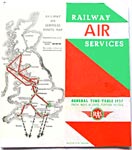
 The Railway Air Services Haldon service and a 1936 Flyer
The Railway Air Services Haldon service and a 1936 Flyer
From May 1934, Railway Air Services operated the Plymouth Roborough
Airport, Haldon, Cardiff to Birmingham route. The service ceased in
September 1938 after Exeter Airport was opened. They operated the de
Havilland Dragon. After the war, they were taken over by the newly
formed British European Airways in January 1947. The rather stylish leaflet on the right was inserted in the city's 1936 guidebook. Unfortunately, the airport had not yet opened, and the terminal did not exist.
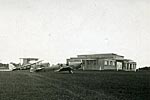 Terminal
building 1938
Terminal
building 1938
Several small aircraft parked to the side of the main terminal in 1938.
When the airport opened for its first flights in 1937, tents were used
for the terminals. The purpose built terminal building was opened by
Sir Kingsley Wood, Minister of Aviation on 30th July 1938.
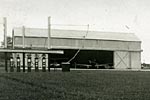 Hangar
building 1938
Hangar
building 1938
The main hangar and fuel pumps at Exeter Airport in 1938.
 C47As
at Exeter airstrip on 5th June 1944
C47As
at Exeter airstrip on 5th June 1944
The 440th Troop Carrier Group arrived at Exeter airstrip on 18th April
1944 in preparation for D-day. There was not enough hardstanding for
the many aircraft, with many standing on grass. They dropped the 101st
Airborne Division to Normandy on 6th June, and continued to ferry
supplies to the army. When suitable airstrips had been captured, they
brought back injured soldiers from the front to be treated in England.
They moved on to Rheims in September 1944, and the RAF returned to
Exeter.
 Sweet
Phyllis - C47A in 1944
Sweet
Phyllis - C47A in 1944
This C47A Skytrain, affectionately named Sweet Phyllis was assigned to 440th
Troop Carrier Group 98 Squadron based at Exeter Airport from the 18th
April 1944 until September 1944. The aircraft appears to have some
damage, indicating the photo was taken after 6th June.
 Chrislea
Super Ace
Chrislea
Super Ace
Built at Exeter, the first flight was in February 1948 at
Exeter
Airport. Seventeen were
eventually produced. They had an innovative control system that some
considered to be dangerous. A later still airworthy Chrislea Skyjeep,
can be found at Eggesford Airfield. After her 1hr 20mins test flight at
Exeter in the
early fifties she ended up in Australia. Photo of a Super
Ace courtesy of Ed Coates Collection
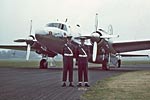 The
Queen Mother's Viking 1954
The
Queen Mother's Viking 1954
The RAF Vickers Viking C2 of the Queen's Flight that brought Queen
Elizabeth, the Queen Mother to Exeter for a visit in 1954. Photo
courtesy of Lydia Barnard.
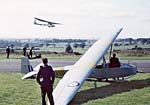 Gliders
of the ATC - early 1950's
Gliders
of the ATC - early 1950's
Exeter Airport was handed over to the Ministry of Civil
Aviation in January 1946 , while the RAF finally left in October 1946.
The RAF 84 Gliding School continued to train ATC Cadets for many more
years at the airport. Here, a flying day for the Gliding School was
photographed by Frederick Charles Thompson in the early 1950's. Photo
courtesy of Lydia Barnard.
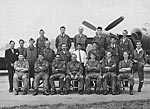 CAACU staff photo 1959 NEW
CAACU staff photo 1959 NEW
CAACU was the 3 Civilian Anti-Aircraft Cooperation Unit. Formed in March 1951 for target towing, testing and instrument calibration for the RAF, Army and Navy. The unity operated many famous aircraft types including Spitfires, Mosquitos and Hawker Hunters. In its twenty years existence, the unit flew over 75,000 hours and provided aircraft for use in films such as Reach for the Sky with Kenneth More in 1956 and 633 Squadron in 1964. Former pilot with CAACU Doug Johns, who supplied the photo is second row, third from left.
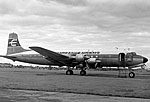 NEW Cunard Eagle Airways DC6 G-APON
NEW Cunard Eagle Airways DC6 G-APON
In 1962, this aircraft flew from Exeter to Norway to ferry NATO troops taking part in an exercise. Delays caused by fog turned a 36 hour roster for the crew into 120 hours before they returned to Heathrow. Doug Johns, mentioned opposite, and Phil Kelly both trained as Engineers at RAF Halton. Doug in the 61st Entry and Phil in the 76th Entry. Doug subsequently trained as a pilot in th RAF and after leaving CAACU flew as a Captain with Westpoint Aviation based at Exeter. Subsequently he joined British Eagle International Airlines at Heathrow where Phil was already working and both flew on the Bristol Britannia together on a number of occasions. Photo from former Flight Engineer Phil Kelly. See the British Eagle website.
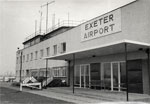 The Airport Terminal 1950
The Airport Terminal 1950
The airport terminal was opened in 1938 – it survived the war and
was not replaced until 1998 . Photo
courtesy of Terry Dickens.
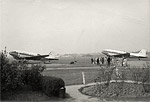 Jersey
Airline 'Dakotas'
Jersey
Airline 'Dakotas'
In 1952, Jersey Airlines (not the original pre-war company)
started a service between Exeter and Jersey using a deHavilland Rapide.
They took delivery of their first deHavilland Heron in 1954. Here, two
Jersey Airline 'Dakotas' are on the tarmac, while passenegers embark on
one for their flight. Photo
courtesy of Terry Dickens.
 A
Lancaster at Exeter
A
Lancaster at Exeter
The
City of Lincoln, Lancaster B1 PA 474 has been part of the Battle
of Britain Memorial Flight since 1973. Here, she is being inspected by
spectators at the airport, during a visit to Exeter Air Day - date
unknown. Photo
courtesy of Lydia Barnard.
 Concorde
lands at Exeter
Concorde
lands at Exeter
An annual event in the 1990s was the arrival of Concorde for
two sub-sonic and one super-sonic flight. The flight plan would take it
across the Bay of Biscay. Concorde is shown landing at the airport on
one of these occasions - year unknown. Photo
courtesy of Lydia Barnard.
Aircraft at Exeter - photos by Alan H Mazonowicz
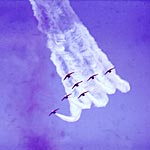 The
Red Arrows
The
Red Arrows
A regular visitor to the Exeter Air Day, the Red Arrows perform their
high-speed and intricate manouveres over the airport in 1977.
 Vulcan V-bomber
Vulcan V-bomber
The Vulcan V-bomber was also a regular visitor to Exeter. The tannoy
would announce the arrival of the aircraft to the
expectant crowd. Looking to the east, towards Honiton a spec would
appear and gradually grow as the huge aircraft made its' pass. Suddenly
the roar of its four Olympus engines would hit the crowd, and children
would put their hands to their ears. This fine photograph of the Vulcan
in 1977 at Exeter shows the open bomb door.
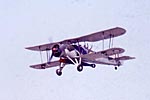 Swordfish
Swordfish
The Fairey Aviation Swordfish may seem old fashoned, ven for the Second
War, but it was this model of aircraft, flying from aircaft carriers,
that sank the Bismark and destroyed the Italian fleet in the Battle of
Taranto. This one was present at the 1977 show, complete with dummy
torpedo. Both the 825 Sqn., and 834 Sqn., flying the Swordfish were
based at Exeter during 1943, to react to German shipping movements in
the Channel.
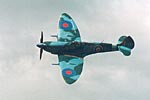 Spitfire
Spitfire
The most famous British World War Two fighter, the Supermarine Spitfire
was always a popular aircraft at Exeter. Spitfire squadrons based at
Exeter included 66 Sqn., during April 1940, and 317 Sqn.,between
July 1941 and April 1941.
 James
Bond 'Little Nellie' autogiro
James
Bond 'Little Nellie' autogiro
This is the autogiro G-ARZB piloted by Ken Wallis that appeared in the
1977
James Bond film You Only Live Twice.
It was a small one-seater autogiro, just 3 metres
in length, a weight of 114 kilos with a top speed of 160 km/h. It's
maximum altitude was 18,000 feet. It was a popular addition to many
airshows at the time and appeared again at Exeter in 1979.
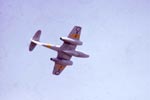 Gloster
Meteor
Gloster
Meteor
This was Britain's firrst operational jet fighter, using the Frank
Whittle designed jet engine. The first Meteors to be deployed at Exeter
were with 222 Sqn., in 1946. It was one of their Exeter based aircraft
that became the first jet aircraft to crash from Exeter, at Powderham
on 1st July 1946. This example, WF391 crashed in 1988, killing both
pilots.
 AirUK F27
AirUK F27
Once a common site at Exeter Airport, this AirUK Fokker Friendship F27
is standing in front of the new control tower, which was built in 1981.
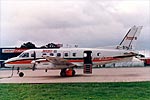 Jersey
European - Bandeirante
Jersey
European - Bandeirante
Manufactured in 1980, this Brazilian Bandeirante in Jersey European
colours is waiting for its next passengers. It was a regular visitor to
Exeter in the 1980s.
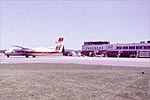 Handley
Page Dart Herald
Handley
Page Dart Herald
In the livery of British Island Airways, this Dart Herald is taxiing
next to th old terminal building during the 1977 airshow. British
Island Airways were taken over by AirUK in 1980.
 Hercules
Hercules
An RAF C-130 Hercules built by the Lockheed Corporation on the apron at
Exeter.
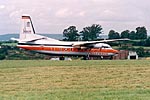 Jersey
European F27
Jersey
European F27
Exeter was one of the most important airports for Jersey European. This
aircraft was first registered in 1988.
 de Havilland Rapide
de Havilland Rapide
The de Havilland DH-89 Rapide was one of the first aircraft types to
land at Exeter in 1937, operated by Railway Air Services. This one
G-ACZE was built in 1934 and is still flying.
 Gloster Meteor
Gloster Meteor
Another photograph of the Gloster Meteor at the 1977 airshow.
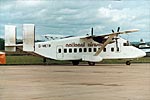 National
Airways Short SD3-30
National
Airways Short SD3-30
Built by Shorts in Belfast, this 1988 registered aircraft was a common
site at Exeter Airport.
 Spitfire
Spitfire
A Spitfire at the 1977 Exeter Air Day.
 Red
Arrows refuelling
Red
Arrows refuelling
The Red Arrows lined up on the tarmac for fuelling during the 1977
Exeter Air Day.
│ Top of Page │